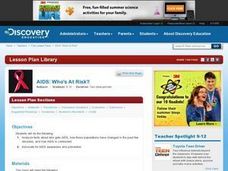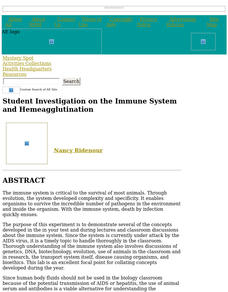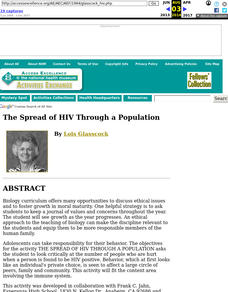Curated OER
Who's at Risk?
Students are asked what do they comprehend about HIV, such as: how does it get transmitted, and what happens to the body once someone contracts the virus. They discuss ways that people can avoid getting and spreading AIDS. Students...
Curated OER
Water Microbes and Human Health Exercise
In this water microbes and human health worksheet, students complete a crossword puzzle given 11 clues about different water born illnesses caused by microbes.
Curated OER
HIV/AIDS: Basic Facts
Students complete worksheets and play the "Onion Ball Question and Answer Game" as an introduction to the basic facts about AIDS and HIV, such as what the virus is, the body fluids that transmit the virus, and the the most common methods...
Curated OER
Opportunistic Diseases
Students explore the concept of opportunistic diseases. In this opportunistic diseases lesson, students take notes on a lecture regarding systemic herpes, candidiasis, cytomegalovirus, tuberculosis, MAC, recurrent pneumonia,...
Curated OER
Students Exploring Cyberspace (SECs) Project
Learners study AIDS and other current topics in a multinational, interdisciplinary fashion. They communicate with students from other countries throughout e-mail to find out how AIDS impacts other societies.
Healthy Native Youth
Chapter 4: Learning About Disease
Communicable diseases are the focus of a lesson that primarily uses discussion, a hands-on activity, and a worksheet to drive their point home. Lotion and glitter create a strong visual for communicable diseases. A practice page provides...
Curated OER
"Asthma: Stopping Attacks Before They Start"
Students study facts about living with asthma. They examine medical treatments and lifestyle changes that can improve the life of asthmatics. They determine the cause and effect relationship.
Curated OER
Student Investigation on the Immune System and Hemeagglutination
Pupils study laboratory protocol for hemagglutination experiments.
Curated OER
The Spread of HIV Through a Population
Students use a model to illustrate the spread of HIV through an adolescent population and, acting in the role of epidemiologists, explore the dilemmas of HIV infection presented by the simulation. beneficence and justice.
Children’s Hospital of Philadelphia
Case Studies: Influenza and HIV
Stop infection spread. Pupils participate in an activity to model infections and replications of viruses. Within the activity, scholars see that viruses may end up with genetic variation and connect that to how some forms of the flu are...
Heritage Foundation
The Constitution, Federalism, and the States
The divide between federal and state government is responsible for much of tension that continues to this day, partly because of the US Constitution. The activities in the 14th lesson in a series of 20 are designed to help learners...
Curated OER
Tracking a Virus
Students simulate the spread of a virus such as HIV through a population by "sharing" (but not drinking) the water in a plastic cup with several classmates. Although invisible, the water in a few of the cups will already be tainted with...
Curated OER
Beef and Beef By-Products
Students examine the various types of beef and the many uses of its by-products. They increase their knowledge by playing a game of "beef bingo."They discuss what parts of beef animals are their by-products.
Curated OER
P.L.E.P: Parts of Blood
Students examine the different parts of blood. In this human blood lesson students work in groups and identify parts of blood and construct a model of human blood.















